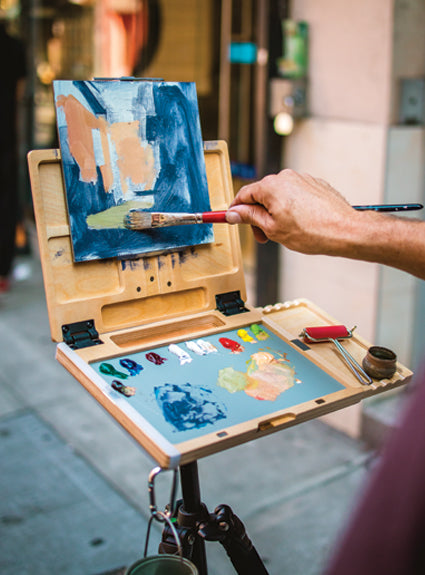INTERVIEW with T. ALLEN LAWSON
LOCATION: Rockport, ME
CAREER: Painter
EDUCATION: American Academy of Art; Chicago, IL. Lyme Academy of Fine Art; Old Lyme, CT
LITTLE KNOWN FACT: I don't think of myself as being creative.
MOST OF YOUR WORK IS COMPRISED OF OUTDOOR SCENES. WHAT FIRST INSPIRED YOU TO BEGIN PAINTING EN PLEIN AIR, AND WHAT CONTINUES TO INSPIRE YOU TODAY?
Most of the work I do now is done in the studio from information and observations acquired outdoors directly from life, but very little of my work is done Plein Air. I spent the first ten or eleven years early in my career painting only Plein Air but I reached a point where I wanted to put more into my paintings. The studio allows me time to develop my work and explore possibilities.
HOW HAS YOUR WORK EVOLVED SINCE THE 1980'S?
In the 80’s my paintings were almost entirely Plein Air. The paintings were done in one setting (about 3 to 31/2 hours.) When a piece worked, it had a certain spontaneity, but I began to feel limited with what I could achieve. I wanted something more from the work so I started to paint in the studio. There I could spend more time developing the paintings. The studio also allows me time to THINK. It allows me to strive for the feeling my subject gives me, instead of a mere reproduction of a scene.
DO YOU CONTINUE TO CHALLENGE YOURSELF AS A PAINTER, AND IF SO, HOW?
I never consciously think about challenging myself, for me the painting is difficult enough. I do try to follow my interests, which leads me to paint new subjects, and I have been painting larger canvases which present a different kind of challenge.
DO YOU HAVE A PREFERRED COLOR PALETTE REGARDLESS OF SUBJECT MATTER?
I work with a full palette with around 18 colors. However, depending on the painting, I may use only four or five colors. I have made an extensive set of color charts. These charts allow me to gauge the spectrum of color and tonality I want each painting to have.
DO YOU HAVE A PREFERRED MEDIUM?
I usually work in oil, though recently I have been working with mixed mediums(watercolor, pastels, and graphite), which have been a lot of fun, and have allowed me to achieve completely different results. I have also begun to draw much much more. I find that there is an intimacy that is reached with drawing that is not achieved with any other medium.
DO YOU HAVE A SPECIFIC TECHNIQUE THAT HAS REALLY HELPED TAKE YOUR PAINTINGS TO THAT "NEXT LEVEL?"
I don’t know if I have a specific technique, but slowing down and working on my paintings for much longer has helped my work more than anything. It is not uncommon for me to work on a piece for over six months. Sometimes I’ll have a painting kicking around for a couple of years. Taking time to think about what I want the painting to say is very important to me.

DURING YOUR WORKSHOPS DO YOU FIND MOST STUDENTS STRUGGLING WITH ANY ONE SPECIFIC PROBLEM? IF SO, WHAT IS IT AND WHAT IS YOUR ADVICE TO OVERCOME IT?
I think the most common problem students make is that they don’t ask themselves what they want their paintings to say. They set up and start to paint without asking even the most basic questions: What am I painting? Do I want this piece to be about the sky or do I want this painting to be about the trees? Do I want to emphasize the darks? Where do I want my point of view to be? To me there is so much more to be said in a painting than just rendering what is in front of you. Strive to make each painting different. Not different just to be different, but by different I mean every subject has an unlimited number of possibilities. Stop and think what you would like each painting to say.
WHERE CAN SOMEONE LEARN MORE ABOUT ATTENDING A WORKSHOP?
I have an exhibition next September so I am not teaching a workshop this year. I enjoy teaching and if anyone is interested in upcoming workshops they can always find information on my website.






